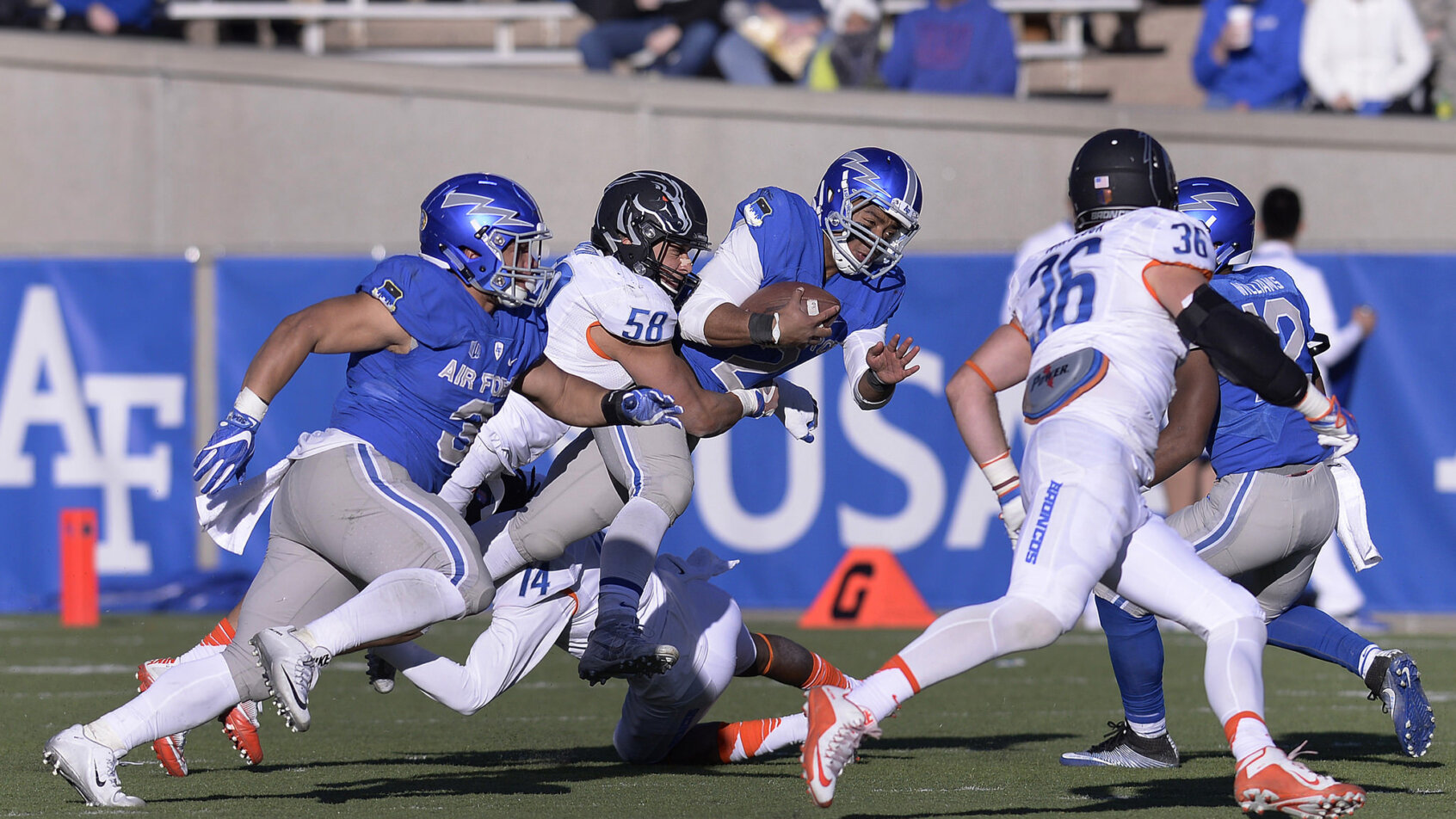The Plight of the Group of Five
By Eric Thompson in College Football
Updated: January 17, 2018 at 9:39 am ESTPublished:

Editor’s note: This is part one of a two-part series on the current College Football Playoff system and its inherent bias against non-power conference schools. In a couple weeks, SBD will be exploring the viability of an exclusive small-conference playoff.
Unless you’re a student, alumni, or perhaps just driving through a small midwestern town, it’s unlikely you ever think about college football’s Group of Five schools. Well, these 60 schools are aware of their afterthought status, and at least one athletic director has come up with a solution.
With many of these football programs heading into an uncertain future, and tired of being passed over by the new College Football Playoff, Northern Illinois athletic director Sean Frazier has proposed a solution: a playoff just for the Group of Five. Selecting representatives only from the American Athletic Conference, Conference USA, the Mid-American Conference, the Mountain West Conference and Sun Belt Conference, this new playoff would actually give these smaller programs something to play for, and a chance at generating more money.
In a few weeks, we’ll look at whether Frazier’s idea could actually work. But today, let’s take a deeper dive into understanding why the suggestion is even necessary. Is it really that improbable that a Group of Five team could ever make the current College Football Playoff?
Yes. Yes it is. Here’s why.
The Money
The problem we’re trying to solve, is that there are rich teams and there are poor teams, then there’s 50 feet of crap, and then there’s us. It’s an unfair game.
–Brad Pitt, Moneyball
Somehow, in a sport that doesn’t actually pay its players, the inequality in spending between programs has a massive impact on success, or lack thereof. In 2015, the median expenses of DI schools on football was a shade under $15.9 million. The average spent by the teams who made the College Football Playoff that year was $33.3 million, a figure that admittedly does get inflated by the absurd $51 million Alabama threw around to make Nick Saban smile. (It didn’t work; the man is incapable of feeling joy.)
But even beyond Alabama’s outrageous spending, a look at the final CFP rankings shows a trend favoring the rich, as only two teams to finish the year in the top 25* had yearly expenses under the median: Houston and Temple. (*Navy’s expenses aren’t made public.)
Obviously, expenses are tied to revenue: the more money a program draws in, the more it will shell out on the coaches and athletes. And at its most basic level, college football revenue isn’t tied to success, but rather what conference you’re a member of, and how large your share of their TV contract is.
Look at garbage football programs like Rutgers and Kansas. In 2015, despite winning just four games between them, each one generated over $20 million more in revenue than Bowling Green and Western Kentucky, teams that went a combined 22-6.
Big money just isn’t achievable unless you can break into a Power Five conference, and as Houston found out last year, that’s not so easy to do. Without that bloated revenue, schools can’t possibly hope to attract top-level players. They can’t offer as many scholarships, access to great facilities or adequate national exposure.
While there’s not a direct correlation between winning and money directed at student athletes, there is a strong relationship between the type of talent you can attract and your spending. For example, none of the CBS’s top 100 high-school recruits signed with a Group of Five school this year. Perhaps it’s not a shock then that only two players from the lesser conferences have finished top three in Heisman voting in the last 20 years.
As if the glamour of going to an SEC school wasn’t enticing enough for a young recruit, the NCAA recently gave Power Five schools more recruiting weapons. After the best conferences were granted autonomy, they used that freedom to grant themselves the ability to provide additional stipends to athletes (ranging from $2,000 to $4,000) to cover costs of living not associated with scholarships. So, essentially, these schools can throw even more money at potential recruits now, growing the gap between them and the Group of Five.
Sure, as the rules have changed for the big schools, so has the revenue generated for the small schools from the College Football Playoff. Under the old BCS system each conference received a mere $3.3 million from bowl season. Now, with the CFP, the Group of Five conferences each receive around $16.7 million.
However, that money could just end up offsetting former revenue streams that are drying up. For example, the most recent TV contract for Conference USA was down from $10 million per year to $2.8 million, which gets divided between 13 schools. Average attendance is also down for the “lesser conferences,” dropping eight-percent from 2010 to 2015. There’s less interest for these conferences as they’re pushed to the periphery of the college football picture.
So the revenues for the Group of Five will never really improve under the current system, at least not enough to make a noticeable difference. But surely Wu-Tang Clan was wrong: cash doesn’t rule everything. Boise State is always in the mix, and their yearly expenses are under $9 million. Why, all it takes is one lucky season, and they could find themselves in the CFP playing against the nation’s best, right?
Wrong.
The System
The new CFP system has erased the cold, emotionless touch of a computer ranking teams, and turned the power over to sensible, wholly “unbiased” humans. But it hasn’t suddenly opened the door for a drastic underdog story, even though everybody is supposed to love an underdog.
In fact, the humans have been even harder on Group of Five schools than our former robot overlords. In the final ten years of the BCS, schools from the Group of Five finished in the top-eight seven times. The highest a team has finished in the first three years of the CFP? 15th.
The issue with the CFP selection committee is the lack of a clear directive. As their own protocol states “ranking football teams is more art than science.” So when faced with two paintings – one by the popular Monet, the other by the unknown Augustus Egg – which do you think these art connoisseurs would take? It’s not going to be the perceived outsider.
No one on the committee grew up dreaming of playing at Toledo. The MAC has never been featured on ABC on Saturday nights. Having been raised on the idea that the power conferences are supreme and the big name schools matter most, these committee members will never view a 12-win team from the Sun Belt conference the same as a 10-win team from the Pac-12.
Even if a lifelong bias could be reversed, the protocol sets up guidelines for what the committee should value when “comparing teams with similar records and pedigree.” And once again, it doesn’t favor the little guys. The criteria to be considered when comparing two teams includes championships, head-to-head results, strength of schedule, and common opponents; but as we saw this year, the committee values one of these components more than others.
The strength of schedule tiebreaker was the biggest factor in why Ohio State was selected for the playoff this year over Penn State, despite the Nittany Lions holding a head-to-head victory over the Buckeyes and a Big Ten Championship. If strength of schedule is going to be the tiebreaker that holds the most weight, then the Group of Five officially stands no chance. Houston finished the year with the highest SOS in the Group of Five at 48th in the nation, and undefeated Western Michigan was way behind at 85th.
Why is that you ask?

The Schedule
We know the committee sees Group of Five conference wins as mouse farts – barely making a peep – so smaller schools have to make a big showcase in their four non-conference games. But as usual, there’s barriers to scheduling impactful games.
Power Five teams typically all follow the same pattern when picking opponents for the their non-conference games: one against a team from another top conference, one cakewalk against an FCS school, then a few middling opponents that are geographically close by. So where a Group of Five school is located can affect the caliber of team it’s able to play. (For example, not a lot of teams are lining up to play Wyoming.)
Another obstacle to getting strong opponents is the fact that many games are scheduled well in advance, as part of home-and-home agreements. Just because a program is good when you shake hands, it doesn’t mean the same will hold true in two years. When you only get one, maybe two, kicks at Power Five teams, it really smarts to catch Nebraska in a down season.
Ultimately, drawing and beating a few ranked opponents will give a team a more impressive resume, but won’t greatly affect its strength of schedule. The SOS formula puts an emphasis on opponents’ record, and opponents’ opponents’ record, so it’s necessary that your conference as a whole have a strong year, and not just against really bad programs. Only then will a Group of Five’s season truly be comparable to the big boys.
The Odds
This season, Boise State’s odds of winning the National Championship are set at around 100/1. When you think about it though, that number is closer to their odds of just getting into the playoffs, before they even have to beat two of the best teams in the nation. And honestly, their playoff chances are even lower than that!
Let’s recap roughly what would have to go right in order for Boise to secure a CFP berth:
- First and foremost, they have to run the table. We saw a very impressive one-loss Houston team in 2015, and the committee did not care for that s**t at all!
- They would have to hope some of the non-conference games they scheduled end up being against quality, ranked opponents.
- Other teams in the Mountain West Conference have to perform well in their non-conference games, to help increase Boise’s overall strength of schedule.
- An absurd number of the teams that are spending triple to quadruple the money of the Broncos would need to have unimpressive three-loss seasons or worse.
- A committee that has never valued the Group of Five conferences would have to decide the Broncos are a more worthy playoff team than not one but two conference champions from the Power Five.
So perhaps you can understand why these teams feel slighted by the current system. The current odds of getting in the dance are low. Like 500/1 low.
Should the CFP ever expand to eight teams (which they seem reluctant to do in the near future), still the only way a Group of Five team would get in is if they system mandates an automatic bid for a non-power school. Otherwise, the committee’s bias against the small conferences will continue. Runner-ups from the SEC and Big Ten would get preferential treatment, and Notre Dame would always find their way in. Say what you will about the BCS, at least the computer wasn’t programmed with such disdain for the little guy.
Fair or not, the Group of Five schools aren’t getting into this tournament. So they can be happy with their consolation prize: sending one team each year to a New Year’s Six bowl that has declining interest; or they can start looking for change. If they choose the latter, they had better start now, because we all know how slow the NCAA can move.
Just look how long it took to get a playoff.
As mentioned at the top, in a couple weeks, we’ll be exploring whether the idea of a Group of Five playoff is a feasible idea, and the odds that it actually comes to fruition. For now, drop your two cents in the comments.

Sports Writer
Eric Thompson has been with SBD since 2015, serving as a sports betting expert in NFL, NHL, NBA, and MLB. If you want someone who eats, sleeps, and breathes sports news and betting, Eric is your man. Having studied economics at university, he understands what value is and how to spot it.



